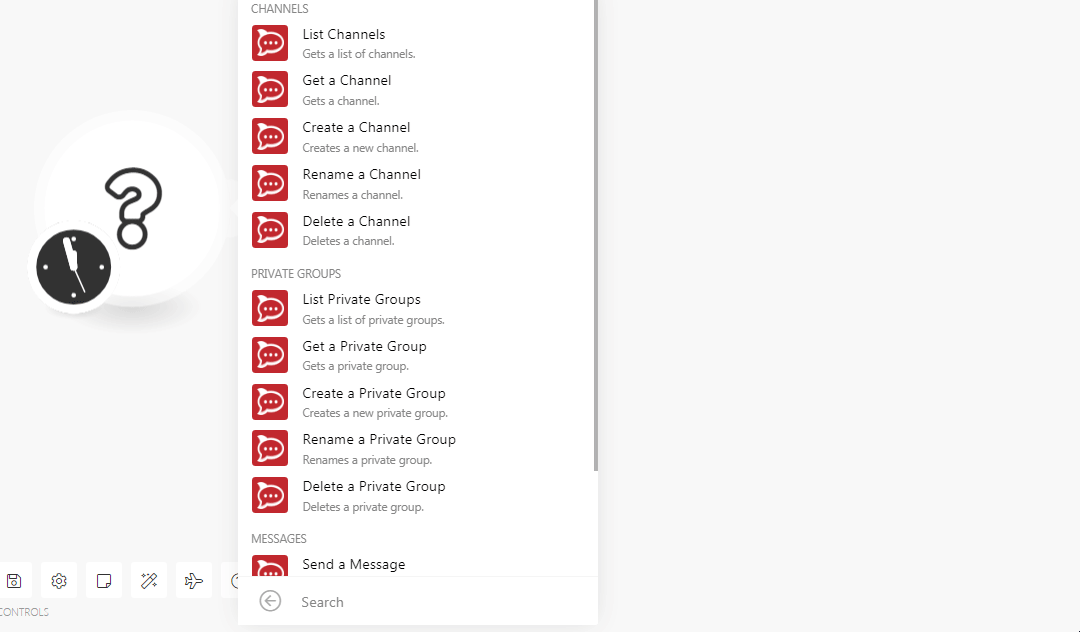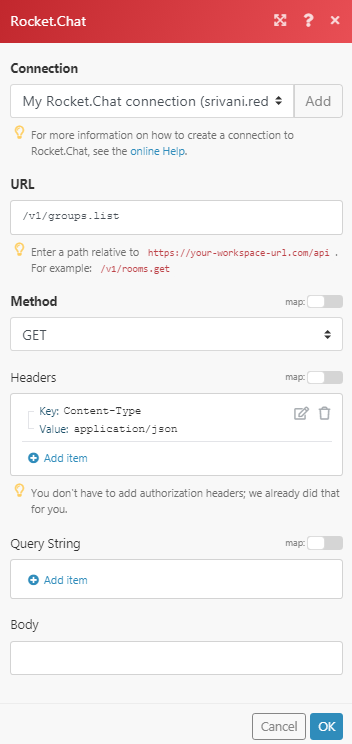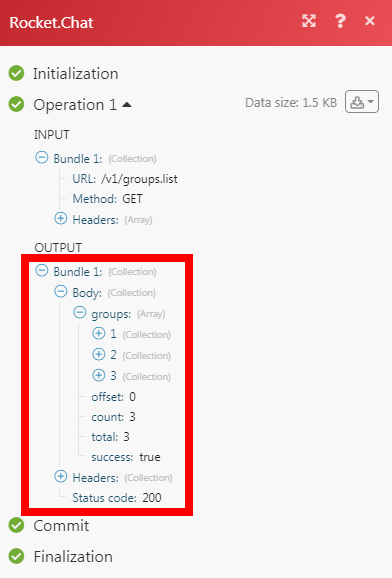rocket.chat
The rocket.chat modules allow you to create, update, list, retrieve. and delete the channels, private groups, and messages in your rocket.chat account.
Getting Started with rocket.chat
Prerequisites
A rocket.chat account
In order to use rocket.chat with Make, it is necessary to have a rocket.chat account. If you do not have one, you can create a rocket .chat account at cloud.rocket.chat/trial.
Note
The module dialog fields that are displayed in bold (in the Make scenario, not in this documentation article) are mandatory!
You can connect to rocket.chat using your username and password or with an auth code.
1. Go to Make and open the rocket.chat module's Create a connection dialog.

2. In the Connection name field, enter a name for the connection.
3. In the Workspace URL field, enter your rock.chat account's URL address. For example, https://integrodev.rocket.chat.
4. Select the Auth Type to establish the connection:
Username and Password
Auth Code
5. In the Username and Password fields, enter your rocket.chat credentials.
6. In the Auth Code field, enter the authentication code details. This field is required if two-factor via OTP is enabled. If you have installed rocket.chat on the cloud then the link to obtain the code is https://open.rocket.chat/accounts/security. You have to login to your account. If you have installed rocket.chat on your server, then the link to obtain the code is https://<domain_name>.rocket.chat/accounts/security.

7. Click Continue.
The connection has been established.
List Channels
Get a list of channels.
Connection | |
Limit | Set the maximum number of channels Make should return during one scenario execution cycle. |
Get a Channel
Gets a channel.
Connection | |
Identificator Type | Select the option to choose the channel details:
|
Channel ID | Select the Channel ID whose details you want to retrieve. |
Channel Name | Select the channel whose details you want to retrieve. |
Create a Channel
Creates a new channel.
Connection | |
Channel Name | Enter a name for the channel. |
Read Only | Select whether the channel is read-only. The member can only view the messages but cannot send them. |
Members | Add the members to the channels by entering their usernames. |
Rename a Channel
Renames a channel.
Connection | |
Channel Name | Enter a name for the channel. |
New Name | Enter a new name for the channel. |
Delete a Channel
Deletes a channel.
Connection | |
Identificator Type | Select the option to choose the channel details:
|
Channel ID | Select the Channel ID you want to delete. |
Channel Name | Select the channel name you want to delete. |
List Private Groups
Gets a list of private groups.
Connection | |
Limit | Set the maximum number of private groups Make should return during one scenario execution cycle. |
Get a Private Group
Gets a private group.
Connection | |
Identificator Type | Select the option to choose the private group details:
|
Private Group ID | Select the Private Group ID whose details you want to retrieve. |
Private Group Name | Select the private group name whose details you want to retrieve. |
Create a Private Group
Creates a new private group.
Connection | |
Group Name | Enter a name for the group. |
Read Only | Select whether the group is read-only. The member can only view the messages but cannot send them. |
Members | Add the members to the channels by entering their usernames. |
Rename a Private Group
Renames a private group.
Connection | |
Group ID | Select the Group ID whose name you want to update. |
New Name | Enter a new name for the private group. |
Delete a Private Group
Deletes a private group.
Connection | |
Identificator Type | Select the option to choose the private group details:
|
Private Group ID | Select the Private Group ID you want to delete. |
Private Group Name | Select the group name you want to delete. |
Send a Message
Post a new message to channel direct or a private group.
Connection | |||||||||||||||||||||||||||||||||
Choose ID | Select the option to send the messages:
| ||||||||||||||||||||||||||||||||
Message To | Select the option to which you want to send the message:
| ||||||||||||||||||||||||||||||||
TM ID | Enter the Message ID to create the thread. | ||||||||||||||||||||||||||||||||
Message Text | Enter the message text which you want to send. | ||||||||||||||||||||||||||||||||
Alias | Enter a message name to display when the message is received. | ||||||||||||||||||||||||||||||||
Emoji ID | Enter the Emoji ID to display along with the message text. | ||||||||||||||||||||||||||||||||
Avatar | Enter the URL address sender's avatar in the message. | ||||||||||||||||||||||||||||||||
Attachments | Add the attachments to the message:
|
Make an API Call
Performs an arbitrary authorized API call.
Connection | |
URL | Enter a path relative to NoteFor the list of available endpoints, refer to the rocket.chat API Documentation. |
Method | Select the HTTP method you want to use: GET to retrieve information for an entry. POST to create a new entry. PUT to update/replace an existing entry. PATCH to make a partial entry update. DELETE to delete an entry. |
Headers | Enter the desired request headers. You don't have to add authorization headers; we already did that for you. |
Query String | Enter the request query string. |
Body | Enter the body content for your API call. |
Example of Use - List Private Groups
The following API call returns all the groups from your rocket.chat account:
URL: /v1/groups.list
Method: GET

Matches of the search can be found in the module's Output under Bundle > Body > groups. In our example, 3 groups were returned:
